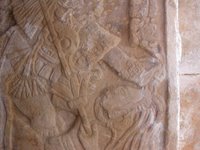
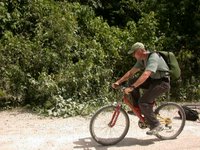
I´ve given up trying to keep up with this trip. So far we´ve put about 7000 miles on the Jeep and I´ve taken over 7000 photos (and deleted about a quarter of them). I know, obsessive-compulsive. Now we are far too far down the road to write or post in chronological order. We´re currently in Merida. To fill in a bit here´s a copy of an email Mr. Lee sent recently about our visit to the ruins at Yaxchilan and Bonampak. Naturally, I have photos to go with this but only have time to post a few at the moment.
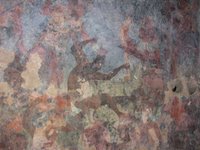

People used to say that the Mayans were completely peaceful but that just isn't so. Murals at Bonampak of ritual mutalation and killing. That's blood dripping from the captive's mutilated hands.
It would be hard for me to describe the past two days without sounding like some dime store adventure pulp, so I won't even try. I can't believe this sort of thing still exists in the 21st century. What follows is just a stream, unedited, typos and misspellings intact, just so I can get it down and then go to bed.
Departing Palenque, we took Hwy 307, a relatively new highway opening Mexico's last frontier, the Lancandon rain forest. It's a shame, really, but I guess humans won't stop until it's all gone. Well, it's not all gone yet.
We drove this road for about 100 miles, passing many tiny farming communities. Given that wood is in good supply and concrete in short supply, the pioneers all build with wood. It looks more like Belize than Mexico, with the exception that there is wave after wave of pioneers. Land that has become too poor to grow corn, beans and squash is burned to promote grass for cattle. Everyone looks fairly prosperous, in a rustic sort of way. As we continued down the new highway, we moved farther and farther back in time and the jungle increasingly pressed in on the road.We reached our destination within a couple hours. Formerly, the road to Frontera Corozal was an all day grind on rutted, pot-holed dirt. This new road will bring quick change, but for now, Frontera Corozal is a sleepy village (sounds cliche, but there's no better way to describe it--it feels more like the Caribbean in pace). These days, Frontera Corozal is the frontier for Mexican eco-tourism. It's a new concept here. The community runs the one lodge. Even though it's a monopoly, it's reasonable, clean and very efficient (although we well never, ever again order the "mojarra frita", a whole fried fish with an eerie piranha-like smile). We stayed in a thatch-roofed cabana with mosquito netting over the bed, nice fan, and tepid water for the shower. The lodge is also the place to book a boat ("lancha") for the hour-long ride down the Rio Usumacinta to Yaxchilan.
We chartered a boat that evening, to set off early in the morning before any potential tour buses. I met the pilot, and he agreed to meet us at 7am the next day. He was five minutes early, and eager to set off. Our boat was typical, a roughly 30 foot open canoe with giant outboard. With only the three of us, we flew over the water. Like the highway (in fact, the Rio Usumacinta has been a very efficient highway itself, for thousands of years), the farther we went, the lusher the forest. After a short time, we left the corn and bean fields behind and found ourselves in basically intact rain forest. We heard howler monkeys and parrots and saw all kinds of water birds.
By 8am, our pilot steered our boat into the mud bank at the foot of Yaxchilan. The mists were just lifting, and it was just getting light. For the next four hours, we were the only people at the site.
There were no guards, no tourists, no people at all. We explored at a leisurely pace, following an excellent guidebook. At one point, standing in the enormous main plaza next to a large stela covered by a giant plastic tarp, I heard what sounded like the start of a tropical downpour. I looked up, and the stream was hitting one spot on the tarp. There was a troupe of howler monkeys just above the tarp, in amongst some spawling tree branches, and they were just waking. Amazingly, the whole troop began to void their bowels at the same time, splatting all over the tarp. We were just far enough away to avoid the overflow.
They continued to stretch and crap for some time. We watched, riveted. They would be one of several different howler monkey troupes we would see that day. The monkeys were in the trees everywhere, the big males making that distinctive roar. What an incredible experience.
Yaxchilan is the rare Mexican preserve that combines actual preservation with lost city adventure and no settlements. Other than the Rio Usumucinta, there is no road to this site. That's the only thing that keeps it so well-protected.
Throughout the day, we visited ruins major and minor and saw the occasional colorful blur, including toucans and parrots. We agreed that this is one of the best things we've ever done.
The ride back was slower since we were going upstream,and our pilot recognized the value of treating people well, so he slowed or stopped for every turtle or crocodile. At one point, this master pilot drifted back quietly to a croc he'd passed (and we hadn't seen, despite our constant focus) and we moved to within 10 feet of the sleeping beastie--I think he was sleeping, because his mouth was wide open. Eventually, he roused and slid languorously into the water and wee moved on. Asha probably took about a thousand pictures.
(Well, not quite a thousand photos but I did get a couple of good close-ups, not with a telephoto lens though. I don't have one. The pilot actually got us this close to the crocodile. It was very cool but we stayed a bit too long and finally the guy slid off into the water to get away from us. We felt bad about it.)
The jeep was packed and ready to go on our return. We hit the road, heading for a campground near Bonampak. There are two Lancandon indian towns here, one more westernized (barely) and one more traditional. Although it was late in the day, I drove to the Bonampak entrance to scope it out for the next day. We were greeted by an old Lancondon man with traditional haircut (long hair, bangs) and western logger garb. On a whim, I asked him if we could camp there, and he checked with some other younger men, and it seemed fine. Time left in the day, we moved on to visit a local site and spread some pesos among the community, our bid to promote forest preservation and eco-tourism.
We took a hike to "las cascadas", one of the most perfect swimmin' holes I've ever seen, complete with sweltering air temps to promote water sporting. Along the way, we passed a tiny undocumented Mayan ruin.
We got back to the Bonampak entrance after closing, but I wasn´t concerned since there wasn't a gate. But all the folks I'd spoken with earlier were gone. In their place was an ancient albino Lancandon man. I don't speak Spanish that well, but it's passable--it was mesmerizing to talk with this man with his thick Maya accent. He spoke Spanish with the most remarkable inflection---I mean, holy shit, a Maya accent, how anachronistic is that? His eyes looked in different directions and his reddish white hair was cut in the traditional Lancondon style, long with bangs. I guess he must have hypnotized me or used some kind of albino shaman trick, because within minutes we were following his grandson to his house, his grandson having just harvested two giant squash from their "milpa" right next to the Bonampak entrance.We parked the jeep in a flat spot and tried to explain to people for whom Spanish is a distant second language that we were going to sleep in the "lancha" on top of our jeep, that we couldn't sleep in a hammock. I don't figure we could have appeared any crazier to these people, but on the other hand, they were looking pretty strange to us, too. The younger generation--there were four generations living here, the albino shaman grandfather the elder at 80--finally grasped that the white thingg on the jeep was a tent, but grandfather never wavered from his position that we were sleeping in our boat.
After some wild comparisons of our culture in Spanish, English and Mayan, the "artesanias" came out, and we were coerced, softly but relentlessly, into purchasing various necklaces and bracelets made out of local seeds. I knew it would happen. We were being ambushed. I bought some stuff, just enough I think.I spent an hour or so talking to grandsons, 20-somethings with some sense that there was a world beyond their own tiny village. Their world was so tiny. There are no schools beyond primary. Everyone works in the field to produce what they eat. There are no jobs. There's very little surplus. With the exception of western clothes and TVs and, amazingly, satellite cable with a hundred or more channels (which every shack had, no matter how humble, leading me to believe that maybe there's a gov't pacification campaign here, since this is still part of the Zapatista zone), these folks had nothing modern, and no possible way to get it or change their lives in any material sense. They all sold trinkets to tourists for folding money, which they wanted for sugar and soap. Again, this sounds like a cliche, but it's the reality as far as I could see.
The grandsons, I believe, had never seen a large map of Mexico, which I happened to have. They knew nothing of their country. They'd never ventured more than 100 miles from where they lived now, for generation after generation after generation. "No dinero", they kept saying, and sure, they were hitting us up hard, and as I say, we bought what we could, what felt comfortable. It got awkward when they invited us for dinner, since we were sure they'd charge in some fashion, and that dinner would be some kind of range chicken or gamey bush meat.
We pretended to be as tired as we really were, and popped the tent, bidding all a very early goodnight. It was just getting dark.
Culture shock would be putting things mildly here. This was more like a cultural nuke. We clammered into our tent, clothes still on, and doused the lights.
We had a very peaceful night. Upon wakening, we hoped that the folks would be working the fields early and we were right. We made a mad dash for the exit, leaving granny a two-pound box of Swiss chocolates and feeling like we'd all hit some kind of cultural snafu, both sides sort of quiet and sheepish.
Who knows what kind of story they're telling now?We reached Bonampak a few minutes later, dirty and a little crazed. We needed to eat. I popped open the back of the Jeep and poured a couple bowls of shredded wheat and raisins, and then I turned around and noticed the small crowd of Lancondones watching the morning's entertainment (us). It felt weird eating in front of these men, so I invited them to join us, distributing the last of our cereal into bowls and pans. One man asked if this is what we ate in America, and I said yes, sure. What is it made of? Wheat, said another, "trigo". I told them it was a different kind of cereal, not like the Mexican cereal since it lacked sugar. They treated it like an exotic dish and everyone ate everything and then washed bowls and spoons and fingers.
We rented decrepit bikes for the 6-mile ride to Bonampak. The site is very tiny, notable for its close alliance to Yaxchilan as a vassal city, and most famously, for its amazing murals. We saw reproductions in Mexico City and elsewhere, but there's no substitute for the actual setting (lost cities, monkeys, parrots, giant butterflies, albino Mayans).
We were filty and exhausted for our ride back to civilization, which, in this case, was Palenque, former hick town, now giant city with the perspective of a couple days in the Lacandon rain forest.
Now I'm going to surf aimlessly for a few minutes and then pester Asha to unplug so we can go to our room and crash. Next stop, Chetumal, sweet blessed funky Chetumal.
L.

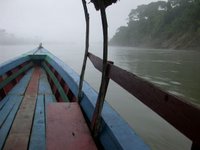
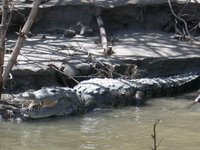
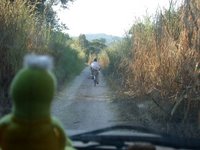
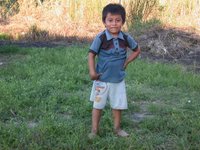
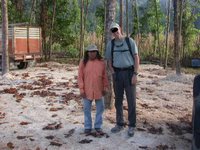
No comments:
Post a Comment